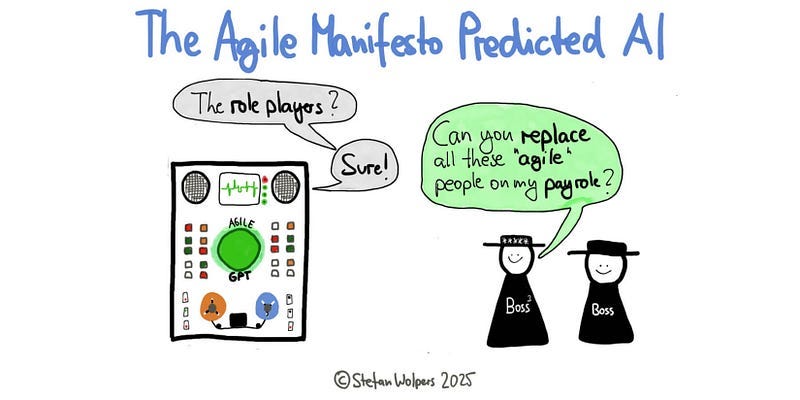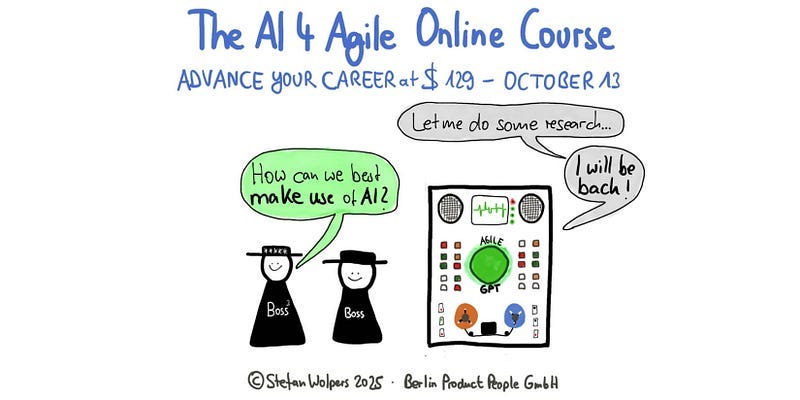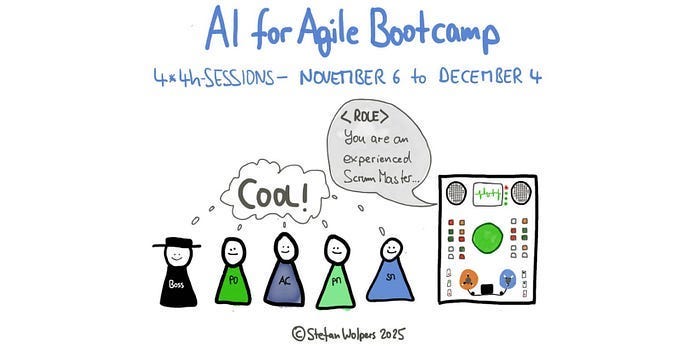Hello everyone!
The Agile world is splitting into two camps: Those convinced AI will automate practitioners out of existence, and those dismissing it as another crypto-level fad. Both are wrong. The evidence reveals something far more interesting and urgent: Principles written in 2001, before anyone imagined GPT-Whatever, align remarkably well with the most transformative technology of recent years.
This is not a coincidence. I believe it is proof that human-centric values transcend technological disruption; it is the Agile AI Manifesto.
And coming back to the two camps, here is what both miss: The biggest threat is not that AI replaces agile practitioners. It is AI that reveals what many organizations have suspected. They never needed Agile practitioners. They needed someone to manage Jira.
If your value proposition is running ceremonies, I deliberately do not refer to them as “events,” maintaining Product Backlogs, and generating burndown charts, AI reveals you were doing work the organization could have automated a decade ago. The separation is between practitioners who do real Agile work and those who perform Agile theater. AI is an expertise detector.
🎓 🇬🇧 🤖 The AI 4 Agile Online Course at $129 — October 13, 2025
I developed the self-paced AI 4 Agile Online Course for agile practitioners, including Product Owners, Product Managers, Scrum Masters, Agile Coaches, and delivery professionals who want to integrate artificial intelligence into their workflows with clarity, ethics, and purpose.
You don’t need to become an AI expert. However, you do need to understand how LLMs like ChatGPT, Claude, or Gemini can support real agile work and where their limitations lie. Like Jim Highsmith said, AI isn’t just a tool, but a new context for agility.
This course shows you how to do precisely that.
What’s Included:
8+ hours of self-paced video modules
A cohort-hardened, proven course design
Learn to 10x your effectiveness with AI; your stakeholders will be grateful
Delve into classic agile use cases of AI
Help your team create more customer value
All texts, slides, prompts, graphics; you name it
Access custom GPTs, including the “Scrum Anti-Patterns Guide GTP”
Enjoy community access for peer learning
Guaranteed: Lifetime access to all course updates and materials; there is a lot more to come
Certificate of completion.
👉 Please note: The course will only be available for sign-up at $129 until October 20, 2025! 👈
🎓 Join the Waitlist of the AI 4 Agile Online Course Now: Master AI Integration for Agile Practitioners — No AI Expertise Required!
🗞 Shall I notify you about articles like this one? Awesome! You can sign up here for the ‘Food for Agile Thought’ newsletter and join 40,000-plus subscribers.
🎓 Join Stefan in one of his upcoming Professional Scrum training classes!
The Broken Debate
Walk into any Agile community event today, and you will encounter two opposing camps, each equally confident and equally wrong:
The AI Maximalists predict the imminent automation of Scrum Masters, Product Owners, and Agile Coaches. Chatbots are replacing consultants, facilitation is reduced to prompts, and human judgment is rendered obsolete.
The AI Luddites, on the other side, dismiss the entire phenomenon as “just another metaverse,” destined to join Web3 and NFTs in the technology graveyard.
Both groups make the same error. They treat AI as either a complete solution or a complete fiction. They miss what is actually happening in organizations right now: a change that neither replaces human expertise nor fades into irrelevance.
Why This Time Actually May Be Different
Web3 and Crypto, replacing traditional finance, and the metaverse, redefining human interaction; both technologies were solutions desperately seeking problems. Seriously, at no time did Agile practitioners wake up thinking, “If only I had a blockchain-based smart contract for my Sprint Goal.”
Generative AI addresses problems that Agile practitioners already experience daily, such as analyzing and categorizing vast amounts of customer feedback, identifying patterns across Retrospectives, and detecting market shifts buried in noise. The problems existed first. AI provides solutions.
In my consulting practice across European enterprises, Product Owners and Product Managers are using AI to complete discovery cycles several times faster, but only when they already know which questions to ask. Retrospectives that draw on AI-identified patterns across multiple Sprints surface systemic impediments that manual review often misses. These effects are not predictions; they are measurements.
Dell’Acqua et al. (2025) confirmed this with 776 professionals at Procter & Gamble [1]. Individuals with AI matched the performance of entire teams without AI. Teams with AI were significantly more likely to produce top-tier solutions. Both AI-enabled groups worked 12–16% faster.
The Alignment Nobody Expected
Here is what makes the Agile Manifesto’s relationship with AI genuinely remarkable. Principles articulated in 2001, before the advent of smartphones, cloud computing, and generative AI, align almost perfectly with how generative AI functions in 2024.
The research confirms three patterns that are observable. These patterns extend beyond individual use cases and apply across Scrum, Kanban, and Extreme Programming:
Pattern One: AI Enhances Preparation, Humans Make Decisions
The human-in-the-loop approach: AI prepares context, humans decide.AI analyzes feedback continuously, surfaces latent needs, and synthesizes insights. But humans judge which insights matter and decide what to build. Without that expertise, AI-generated synthesis remains useless data.
AI assists with code review and identifies complexity. However, humans ultimately determine whether software effectively solves customer problems. AI provides system insights. But teams navigate trade-offs and organizational constraints. The Manifesto’s principle that “the best architectures, requirements, and designs emerge from self-organizing teams” remains intact, as decision-making stays with humans who understand context and relationships.
🖥 💯 🇬🇧 AI for Agile BootCamp #4 — November 6 — December 4, 2025
The job market’s shifting. Agile roles are under pressure. AI tools are everywhere. But here’s the truth: the Agile pros who learn how to work with AI, not against it, will be the ones leading the next wave of high-impact teams.
So, become the one who professional recruiters call first for “AI‑powered Agile.” Be among the first to master practical AI applications for Scrum Masters, Agile Coaches, Product Owners, Product Managers, and Project Managers.
Tickets also include lifetime access to the corresponding online course, once it is published. The class is in English. 🇬🇧
Learn more: 🖥 💯 🇬🇧 AI for Agile BootCamp #4 — November 6 — December 4, 2025.
Customer Voice: “The AI for Agilists course is an absolute essential for anyone working in the field! If you want to keep up with the organizations and teams you support, this course will equip you with not only knowledge of how to leverage AI for your work as an Agilist but will also give you endless tips & tricks to get better results and outcomes. I thoroughly enjoyed the course content, structure, and activities. Working in teams to apply what we learned was the best part, as it led to great insights for how I could apply what I was learning. After the first day on the course, I already walked away with many things I could apply at work. I highly recommend this course to anyone looking to better understand AI in general, but more specifically, how to leverage AI for Agility.” (Lauren Tuffs, Change Leader | Business Agility.)
Pattern Two: Continuous Feedback Goes from Aspiration to Operational Reality
“Welcome changing requirements, even late in development” sounds impossible because detecting and responding to change requires enormous information processing. AI makes this Agile Manifesto principle operationally viable at scale.
Customer collaboration becomes continuous rather than periodic when AI monitors behavioral patterns, sentiment, and support conversations in real-time. What required quarterly research cycles now happens weekly or daily: Market shifts surface through AI-powered pattern recognition across data sources too vast for manual analysis.
Teams make adaptation decisions informed by a comprehensive analysis rather than a gut feeling. “Our highest priority is to satisfy the customer” shifts from well-meaning intent to operational reality when you discover what satisfies customers faster than competitors can. (Isn’t that the essence of “Agile,” learning faster than the competition?)
Pattern Three: AI Makes Face-to-face Conversation Exponentially More Valuable
The Agile Manifesto declares, “face-to-face conversation is the most efficient and effective method of conveying information.” AI does not replace this. It makes it massively more valuable by handling information processing while humans focus on judgment, relationship-building, and collaborative decision-making.
The Scrum Masters or Agile Coaches who arrive at stakeholder meetings with an AI-synthesized analysis of political positions do not replace conversation. They transform it from information gathering to strategic negotiation. AI can identify the top five pain points. It cannot read the room during a tense meeting and know when to push versus when to back off. That is your moat.
Dell’Acqua et al. (2025) [1] found that people using AI reported higher positive emotions and lower negative emotions. When AI removes information processing burden, humans focus more effectively on relationship work. Teams using AI for customer analysis have richer conversations, not fewer. The Agile Manifesto got it right: human conversation is irreplaceable.
The Contrarian Position Nobody’s Voicing
Here is what both camps miss: The biggest threat is not that AI replaces agile practitioners. It is AI that reveals what many organizations have suspected. They never needed Agile practitioners. They needed someone to manage Jira.
If your value proposition is running ceremonies, I deliberately do not refer to them as “events,” maintaining Product Backlogs, and generating burndown charts, AI reveals you were doing work the organization could have automated a decade ago. The separation is between practitioners who do real Agile work and those who perform Agile theater. AI is an expertise detector.
AI Cannot Read the Room (And That’s Your Moat)
AI can analyze support tickets and identify the top five pain points. It cannot read the room during a tense stakeholder meeting and knows when to push versus when to back off, as it lacks empathy and an understanding of the current company’s politics and personal agendas of stakeholders. It cannot build psychological safety that allows teams to admit they do not understand the architecture. It cannot navigate organizational resistance by understanding which stakeholders need data, who needs stories, and who needs political cover.
These capabilities (reading context, building trust, facilitating difficult conversations, navigating politics) are your moat. AI makes this separation absolute. A mediocre practitioner armed with AI remains mediocre, now producing mediocre outputs faster. An expert practitioner armed with AI becomes significantly more effective.
Why “Good Enough” Agile Just Died
An experienced Product Owner using AI can now test ten positioning hypotheses in the time previously required for one or two. A skilled Scrum Master can analyze team dynamics across six Retrospectives to identify systemic impediments that manual review would probably miss.
The era of “good enough Agile” is coming to an end because “good enough” practitioners cannot fully leverage what AI offers. Organizations that recognize the value of this effect invest in structured AI capability development for expert practitioners. Expertise plus AI creates a competitive advantage. AI without expertise creates expensive noise. This reality drove overwhelming enrollment in my October cohort, with a waiting list comprising 6,000-plus peers.
What to Do Monday Morning
The strategic question, “Will AI amplify or replace me?”, matters less than the tactical one: “What am I doing this week to ensure AI is amplifying my capabilities?” To get your reflection going:
For Scrum Masters:
Take your last three Retrospectives. Utilize AI to analyze transcripts or notes and identify patterns that may have been overlooked manually. Then design one facilitation experiment based on that insight. The value is not the AI analysis. It is whether you can translate it into better facilitation. If you cannot, the AI reveals a gap in your expertise.
For Product Owners and Product Managers:
Take your last 100 customer support tickets or user feedback items. Use AI to synthesize patterns and identify the top five latent needs. Then spend one hour with your Developers discussing whether these needs align with your product strategy and how you would validate them. If you cannot lead that conversation effectively, the AI reveals you do not understand product discovery fundamentals.
For Agile Coaches:
Take your current client engagement. Utilize AI to analyze available organizational data, including meeting patterns, communication flows, and decision-making dynamics. Identify one systemic impediment you had not previously surfaced. Then design one intervention to address it. If you cannot design that intervention, the AI reveals you are delivering playbooks, not coaching.
The Agile Manifesto predicted this moment by understanding something timeless: technology serves people, not the other way around. The practitioners who thrive will be those who make that principle operational this week, not eventually.
The question each practitioner should ask is simple: Will I dismiss this as hype, embrace it as replacement, or learn to wield it as amplification?
Those preparing for this shift are investing in structured capability development, which we will explore starting October 13.
Conclusion
The Agile Manifesto remains relevant not despite AI, but because of it. The Manifesto authors got something right: Principles built on human needs survive technology changes. AI amplifies what you bring: Bring expertise, judgment, and the ability to handle human complexity; AI makes you more effective. Bring only mechanical competence, and AI shows you were always replaceable.
Your choice. Choose wisely.
References
[1] Dell’Acqua, F., Ayoubi, C., Lifshitz-Assaf, H., Sadun, R., Mollick, E. R., Mollick, L., Han, Y., Goldman, J., Nair, H., Taub, S., & Lakhani, K. R. (2025). “The Cybernetic Teammate: A Field Experiment on Generative AI Reshaping Teamwork and Expertise.” Harvard Business School Working Paper №25–043. Available at: https://papers.ssrn.com/sol3/papers.cfm?abstract_id=5188231
[2] Harvard Business School Digital Data Design Institute. (2025). “The Cybernetic Teammate: How AI is Reshaping Collaboration and Expertise in the Workplace.” Available at: https://d3.harvard.edu/the-cybernetic-teammate-how-ai-is-reshaping-collaboration-and-expertise-in-the-workplace/
[3] Mollick, E. (2025, March 22). “The Cybernetic Teammate.” One Useful Thing. Available at:
📖 Agile AI Manifesto — Related Posts
AI Risks: Why Product Professionals Are Sleepwalking Into Strategic Irrelevance
Ethical AI in Agile: Four Guardrails Every Scrum Master Needs to Establish Now
Generative AI in Agile: A Strategic Career Decision
Contextual AI Integration for Agile Product Teams
👆 Stefan Wolpers: The Scrum Anti-Patterns Guide (Amazon advertisement at no cost to you.)
📅 Training Classes, Meetups & Events 2025
Upcoming classes and events:
🖥 💯 🇩🇪 October 21–22 — Live Virtual Class: Professional Scrum Product Owner Training (PSPO I; German)
🖥 💯 🇬🇧 November 6-December 4 — Live Virtual Cohort: AI for Agile BootCamp Cohort (English)
🖥 💯 🇬🇧 November 10–11 — Live Virtual Class: Professional Scrum Master — Advanced Training (PSM II; English)
🖥 🇩🇪 December 9–10 — Live Virtual Class: Professional Scrum Product Owner Training (PSPO I; German)
🖥 🇬🇧 December 16–17 — Live Virtual Class: Professional Scrum Master — Advanced Training (PSM II; English)
🖥 🇬🇧 December 18 — Live Virtual Class: Professional Scrum Facilitation Skills Training (PSFS; English)
👉 See all upcoming classes here
📺 Join 6,000-plus Agile Peers on YouTube
Now available on the Age-of-Product YouTube channel:
Hands-on Agile #68: How to Analyze Unstructured Team Interview Data with AI.
Hands-on Agile 2025: The 5 Obstacles to Empowered Teams — Maarten Dalmijn
Hands-on Agile 2025: The Top Reasons Why a Product Strategy Fails — Roman Pichler
Hands-on Agile 2025: Taylorism-Lean-Agile-Product Mindset — Jonathan Odo
Hands-on Agile Extra: How Elon Musk Would Run YOUR Business mit Joe Justice
🎓 Do You Want to Read More Like This?
Also:
📅 Join 6,000-plus peers of the Hands-on Agile Meetup group
🐦 Follow me on Twitter and subscribe to my blog, Age of Product
💬 Alternatively, join 20,000-plus peers of the Slack team “Hands-on Agile” for free.







